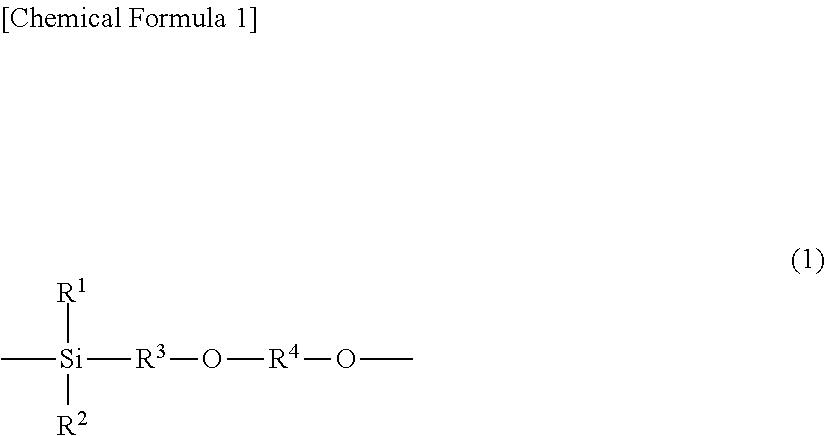Aerogel
a gel and aerogel technology, applied in the field of aerogel, can solve the problems of gel shrinkage, large labor and time, etc., and achieve the effects of improving handleability, excellent thermal insulation properties, and excellent thermal insulation properties
- Summary
- Abstract
- Description
- Claims
- Application Information
AI Technical Summary
Benefits of technology
Problems solved by technology
Method used
Image
Examples
example 1
[0122]40.0 parts by mass of carbinol-modified siloxane “X-22-160AS” represented by the above formula (A) (product name, manufactured by Shin-Etsu Chemical Co., Ltd., average molecular weight: 932 g / mol) as a polysiloxane compound, 60.0 parts by mass of methyltrimethoxysilane “LS-530” (product name, manufactured by Shin-Etsu Chemical Co., Ltd.; hereinafter, abbreviated to “MTMS”) as a silicon compound, 120.0 parts by mass of water and 80.0 parts by mass of methanol were mixed, and 0.10 parts by mass of acetic acid were added thereto as an acid catalyst, and reacted at 25° C. for 8 hours to obtain sol. 40.0 parts by mass of 5% concentration of ammonia water were added as a base catalyst to the obtained sol, which was gelled at 60° C. for 8 hours and then aged at 80° C. for 48 hours to obtain wet gel. Then, the obtained wet gel was dipped in 2500.0 parts by mass of methanol and washed at 60° C. over 12 hours. This washing operation was performed three times while the methanol was repla...
example 2
[0123]200.0 parts by mass of water, 0.10 parts by mass of acetic acid as an acid catalyst, 20.0 parts by mass of cetyl trimethyl ammonium bromide (manufactured by Wako Pure Chemical Industries, Ltd.; hereinafter, abbreviated to “CTAB”) as a cationic surfactant and 120.0 parts by mass of urea as a thermally hydrolyzable compound were mixed, and 40.0 parts by mass of X-22-160AS represented by the above formula (A) as a polysiloxane compound and 60.0 parts by mass of MTMS as a silicon compound were added thereto and reacted at 25° C. for 2 hours to obtain sol. The obtained sol was gelled at 60° C. for 8 hours and then aged at 80° C. for 48 hours to obtain wet gel. Then, aerogel 2 having structures represented by the above formulas (1) and (1a) was obtained in the same way as in Example 1.
example 3
[0124]200.0 parts by mass of water, 0.10 parts by mass of acetic acid as an acid catalyst, 20.0 parts by mass of CTAB as a cationic surfactant and 120.0 parts by mass of urea as a thermally hydrolyzable compound were mixed, and 40.0 parts by mass of a both terminally difunctional alkoxy-modified polysiloxane compound represented by the above formula (B) (hereinafter, referred to as “polysiloxane compound A”, average molecular weight: 966 g / mol) as a polysiloxane compound and 60.0 parts by mass of MTMS as a silicon compound were added thereto and reacted at 25° C. for 2 hours to obtain sol. The obtained sol was gelled at 60° C. for 8 hours and then aged at 80° C. for 48 hours to obtain wet gel. Then, aerogel 3 having ladder-type structures represented by the above formulas (2) and (3) was obtained in the same way as in Example 1.
[0125]The “polysiloxane compound A” was synthesized as follows: first, in a 1 L three-neck flask equipped with a stirrer, a thermometer and a Dimroth condens...
PUM
| Property | Measurement | Unit |
|---|---|---|
| temperature | aaaaa | aaaaa |
| temperature | aaaaa | aaaaa |
| temperature | aaaaa | aaaaa |
Abstract
Description
Claims
Application Information
 Login to View More
Login to View More - R&D
- Intellectual Property
- Life Sciences
- Materials
- Tech Scout
- Unparalleled Data Quality
- Higher Quality Content
- 60% Fewer Hallucinations
Browse by: Latest US Patents, China's latest patents, Technical Efficacy Thesaurus, Application Domain, Technology Topic, Popular Technical Reports.
© 2025 PatSnap. All rights reserved.Legal|Privacy policy|Modern Slavery Act Transparency Statement|Sitemap|About US| Contact US: help@patsnap.com



